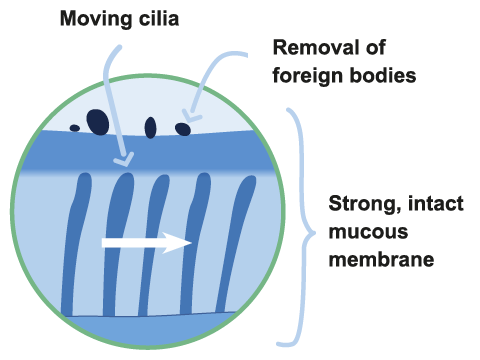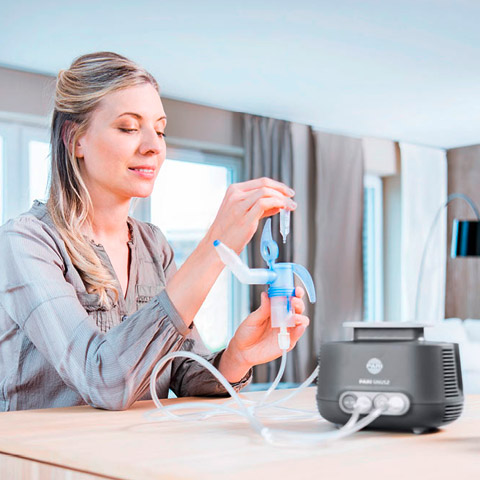What is mucociliary clearance? And what does it have to do with protection against viruses, other pathogens and harmful environmental influences? It is, in a nutshell, the innate self-clearing programme our airways have at their disposal. If it is impaired, it makes life easier for pathogens such as viruses and harmful environmental influences. Regular inhalation therapy with a suitable inhalation device and isotonic saline solution supports mucociliary clearance. If you are already ill and have a build-up of secretions, inhalation therapy with hypertonic saline solution can help.

Our airways are coated with a mucous membrane: from the nasal epithelium down into the fine bronchi. The mucous membrane consists of a watery layer (sol phase) and a thicker layer (gel phase).
In the watery layer, the cilia move in coordinated waves. If pathogens, allergens or other particles reach the airways through respiration, they stick to the mucous layer. The cilia move in coordinated waves towards the mouth and transport the thick gel layer with the unwelcomed intruders towards the mouth where they are then coughed up.
Intact mucociliary clearance is, in this sense, the first line of defence of our innate immune system.
A well-functioning mucociliary clearance system is thus a very effective protective mechanism. However, it can be compromised. Viruses have a vested interest in getting past this first line of defence and multiplying in the host organism. Environmental influences such as cold weather and dry central heating can affect mucociliary clearance. This is why respiratory diseases tend to do the rounds in the colder months of the year.
Dry, cold air or central heating dries out the mucous membranes and makes them more susceptible to viruses and other pathogens. If the airways are then infected, this often leads to excess production of secretions and swelling of the mucous membranes.
Inhalation of isotonic saline solution with a nebuliser plays a vital role in keeping the airways moist and so keeps mucociliary clearance intact. This is why inhalation therapy with isotonic saline solution is an excellent way to keep airway infections (such as RSV) at bay 1.
If you have an infection with a pathogen, the body will often produce excess mucus. This also applies to some chronic respiratory diseases. This thick mucus and the swollen mucous membranes can impact respiration.
The mucus-clearing effect of a light, hypertonic saline solution such as MucoClear 3% is well-documented and well-tolerated.

Find out here why inhalation with saline solution can help in many different clinical pictures.
Contact us
Any questions? You can reach our service center at this number:
+49 8151 279-5220
© 2025 PARI GmbH Spezialisten für effektive Inhalation